Lead Generation Email Campaigns: Playbook for Converting Prospects 2025
Reach the right buyer at the exact moment they’re ready to talk
Blogby JanAugust 13, 2025

Most businesses approach email lead generation like throwing spaghetti at the wall. They build generic lists, craft one-size-fits-all messages, and blast them to thousands of prospects hoping something sticks.
Here's the problem: that approach died around 2018. Modern lead generation email campaigns succeed through precise targeting and messaging, not spray-and-pray tactics. The winning teams focus on reaching the right people at exactly the right moment with messages that feel personally crafted.
The difference is dramatic. Generic email blasts get 1% response rates if you're lucky. Targeted lead generation email campaigns consistently hit 2%+ because you're reaching people when they're actually ready to listen.
Why Most Email Campaigns Fall Flat
Traditional email marketing operates on hope. You hope your message reaches the right person at the right time when they happen to need your solution. The math is terrible.
Think about your own inbox. How many generic sales emails do you delete without reading? Probably 90% of them. Your prospects do the same thing to your campaigns.
Lead generation email campaigns that work flip this approach entirely. Instead of interrupting random people, you identify specific signals that indicate buying intent, then reach out when those signals appear.
Timing Problem Kills Results
Most email campaigns ignore timing completely. You download a list from your favorite database, write a sequence, and hope for the best. But knowing someone is a "Marketing Director at a SaaS company" tells you nothing about whether they need your solution right now.
Maybe they just implemented a competing solution last month. Maybe they're in budget freeze mode. Maybe they're actively evaluating vendors but you have no idea.
Successful campaigns solve the timing problem by focusing on behavioral triggers instead of static demographics. Someone who just posted about hiring challenges probably needs hiring solutions. Someone who announced funding likely has budget for growth tools.
Data Quality Destroys Everything
Even good timing can't save campaigns with terrible data. Email addresses that bounce, contact information that's months out of date, personalization details that are completely wrong.
Bad data kills deliverability, wastes your time, and makes your company look unprofessional. Most email databases are 20-30% inaccurate, which means you're paying to damage your sender reputation.
Quality lead generation email campaigns start with quality data. That means real-time enrichment, verification processes, and data sources that actually stay current.
What Works in 2025?
Successful lead generation email campaigns combine three elements that most companies get wrong: trigger-based targeting, comprehensive data enrichment, and systematic follow-up.
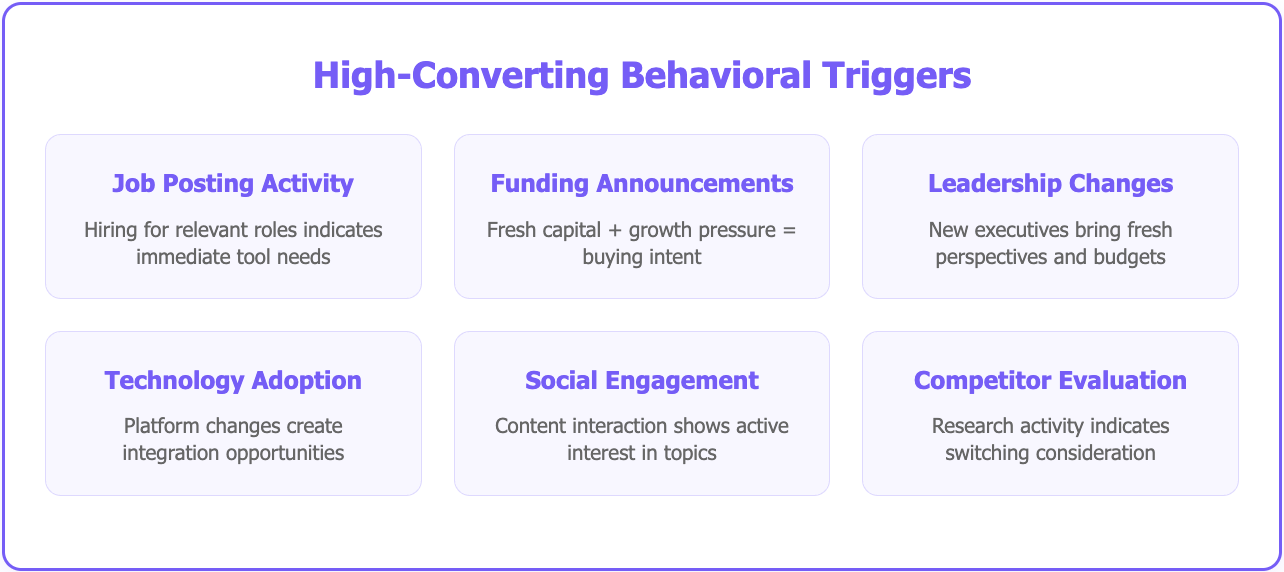
Trigger-Based Campaign Strategies
Instead of demographic targeting, focus on behavioral signals that indicate immediate need or buying intent.
High-converting triggers:
- Job posting activity (hiring for relevant roles)
- Funding announcements and growth milestones
- Leadership changes and team expansions
- Technology adoption signals
- Social media engagement with relevant topics
- Competitor evaluation activity
Databar.ai automates this entire process by monitoring multiple trigger sources simultaneously. When prospects show buying signals, it automatically enriches their profiles and feeds them into your campaign sequences.
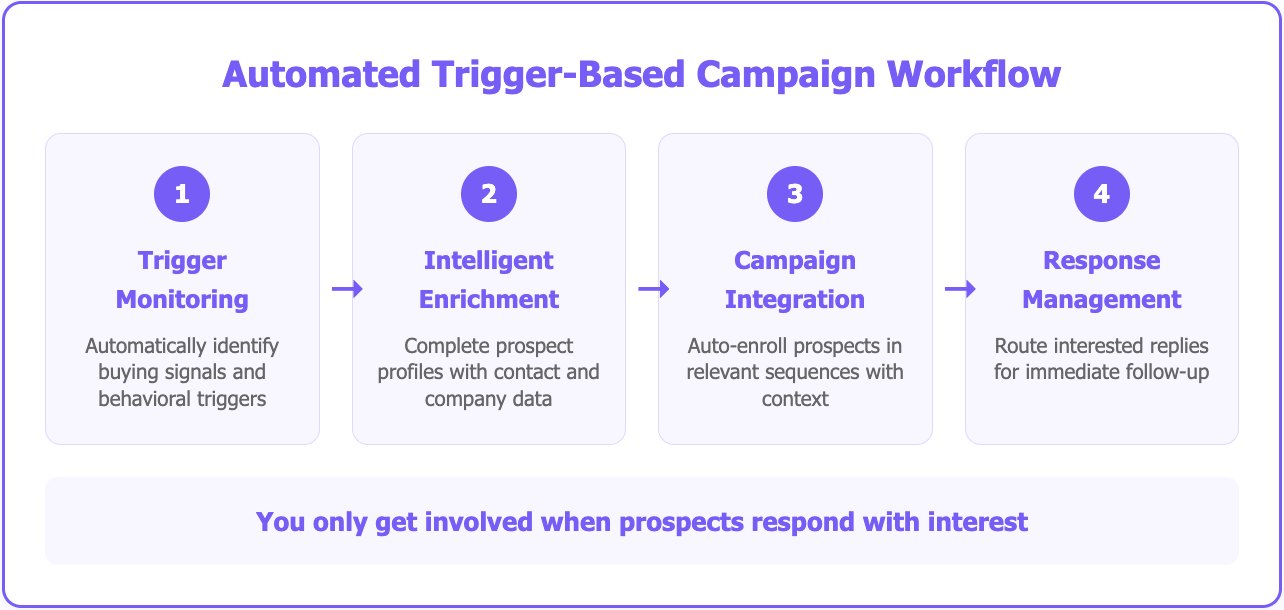
The Right Prospect at the Right Time
Databar's approach differs from traditional list building because it focuses on timing and context rather than just demographics. Here's how it works:
Step 1: Trigger Monitoring
Set up workflows that automatically identify companies showing specific buying signals. For example, monitor job postings for "Marketing Operations Manager" roles if you sell marketing automation tools.
Step 2: Intelligent Enrichment
When triggers fire, Databar automatically enriches prospect profiles with comprehensive data - contact information, company intelligence, recent news, and behavioral context.
Step 3: Campaign Integration
Enriched prospects flow directly into your email sequences with perfect timing and complete personalization context.
The result? Way higher response rates because you're reaching people when they're actively experiencing problems you solve.
Multi-Touch Sequences Convert a Lot Better
One-email campaigns are dead. Modern prospects need 5-8 touchpoints before they're ready to engage. But most follow-up sequences are terrible because they're generic and add no value.
Effective sequence structure:
- Email 1: Reference the specific trigger that qualified them
- Email 2: Provide relevant insight or case study
- Email 3: Clear call to action with easy next step
Each message should provide standalone value while building toward a natural conversation.
Campaign Types That Consistently Deliver
Different situations require different campaign approaches. Here are the four types that generate the best results:
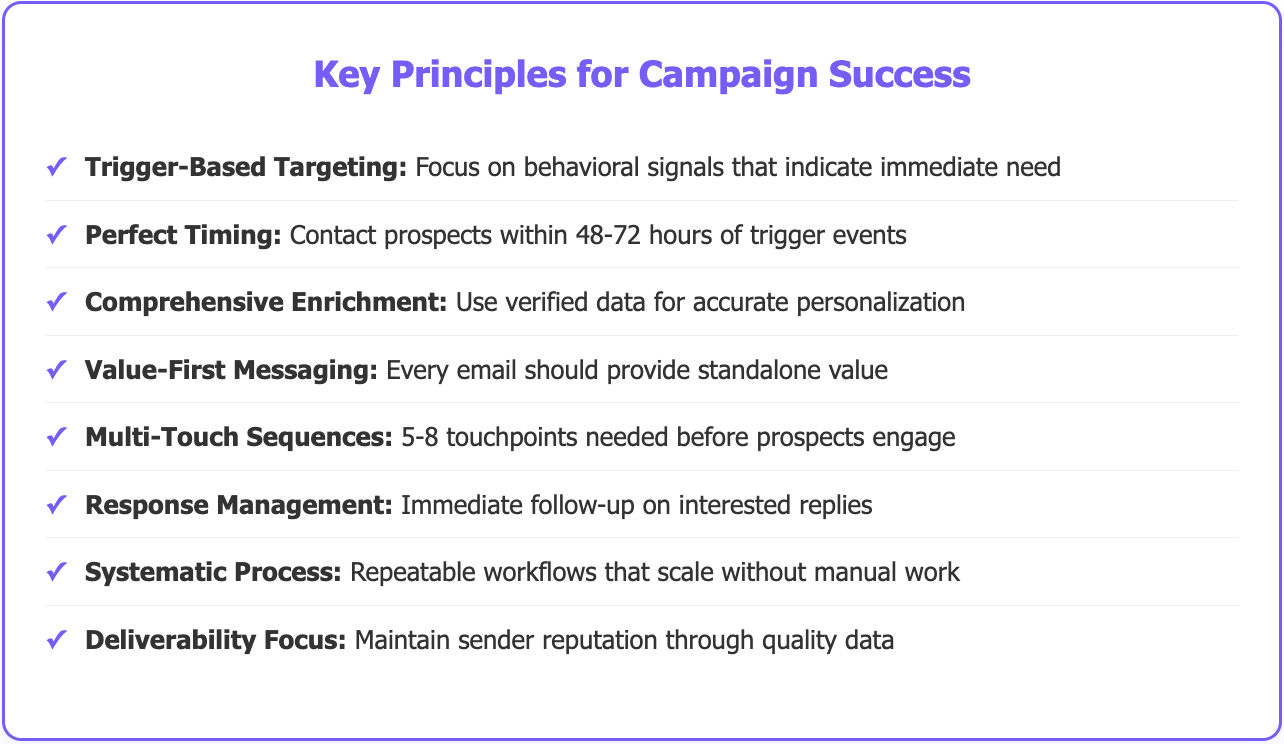
Cold Outreach Campaigns
Best for: Acquiring new prospects who've shown buying signals
Cold outreach works when you contact people at optimal moments with relevant context. The key is perfect timing and personalization based on recent trigger events.
Example workflow: Companies posting sales operations job openings get contacted within 48 hours with messages referencing their hiring needs and offering relevant insights about scaling sales operations.
Nurture Sequences
Best for: Warming leads who aren't ready to buy immediately
Nurture campaigns keep you top-of-mind while providing consistent value. These work best for longer sales cycles where prospects need education before they're ready to buy.
Content focus: Industry insights, case studies, trend analysis, and helpful resources rather than direct sales pitches.
Triggered Behavioral Campaigns
Best for: Responding to specific prospect actions or events
These campaigns fire automatically when prospects take specific actions - visiting your pricing page, downloading content, or showing other intent signals.
Example: Someone visiting your pricing page gets an email within hours offering to discuss their specific use case and answer questions.
Re-engagement Campaigns
Best for: Winning back prospects who went cold
Re-engagement campaigns attempt to restart conversations with prospects who stopped responding. Success requires new angles, updated context, or changed circumstances.
Approach: Reference time passage, company changes, or new developments that might renew their interest.
Building Your First High-Converting Campaign
Let me walk through creating a complete trigger-based campaign using companies posting marketing operations roles as our example.
Step 1: Campaign Strategy and Setup
Target criteria:
- Companies posting "Marketing Operations," "Marketing Automation," or "Growth Marketing" roles
- Company size 100-1000 employees (budget authority sweet spot)
- Posted within 72 hours (timing relevance)
- B2B focus with likely need for marketing tools
Step 2: Automated Trigger Detection
Use Databar.ai to monitor job boards, company career pages, and LinkedIn for relevant postings. When it identifies matching opportunities, the system automatically:
- Enriches company profiles with comprehensive intelligence
- Identifies decision-makers (VP Marketing, CMO, Marketing Directors)
- Gathers contact information through waterfall enrichment
- Analyzes recent company activity and news
- Scores prospects based on trigger strength and context
Step 3: Sequence Development and Personalization
Create message sequences that reference the specific job posting and demonstrate understanding of their situation:
Email 1 (Day 1): Job Posting Reference
"Saw you're hiring a Marketing Operations Manager - timing suggests you're scaling the marketing engine. The first 90 days are crucial for new Marketing Ops hires. Here's what usually makes or breaks their success..."
Email 2 (Day 4): Relevant Case Study
"Following up on your Marketing Ops hire - reminded me of [Similar Company] when they were at comparable growth stage. They hit the same scaling challenges around data and attribution. Here's how they solved it..."
Email 3 (Day 8): Industry Insights
"Quick insight relevant to your Marketing Ops buildout: 72% of fast-growing companies struggle with marketing data integration in their first year of scaling. Here's what the successful ones do differently..."
Email 4 (Day 14): Soft Meeting Request
"Been thinking about your marketing operations scaling plans. Would be interesting to share what other companies at similar growth stages have done to set up their new Marketing Ops hire for immediate impact..."
Step 4: Automation and Integration
Databar integrates directly with email platforms like Instantly, Smartlead, Salesforge or Reply.io to automatically:
- Enroll qualified prospects in appropriate sequences
- Personalize messages based on enriched data
- Schedule optimal send times
- Track engagement and responses
- Route interested replies for immediate follow-up
The entire process runs automatically. You only get involved when prospects respond with interest.
Advanced Campaign Optimization Techniques
Once basic campaigns are running successfully, these advanced approaches can significantly improve results:
Dynamic Content Personalization
Move beyond basic merge tags to dynamic content that adapts based on prospect characteristics:
Company stage-based messaging: Early-stage startups get different messaging than established enterprises, even for the same job posting trigger.
Industry-specific case studies: SaaS companies see SaaS examples, healthcare companies see healthcare case studies.
Geographic relevance: Reference local market conditions, events, or competitive landscape.
Multi-Channel Coordination
Coordinate email campaigns with LinkedIn outreach and other channels for maximum impact:
Typical sequence flow:
- 1: Email with job posting reference
- 2: LinkedIn connection request with context
- 3: LinkedIn message with additional value
- 4: Email with case study
- 5: LinkedIn message with meeting request
Each touchpoint reinforces the others while maintaining consistent messaging and positioning.
Behavioral Response Automation
Set up automated responses based on prospect behavior:
Out-of-office replies: Pause sequence and restart when they return
Positive responses: Send lead magnet or route immediately to sales team with full context
Common Mistakes That Kill Campaign ROI
Most email campaign failures stem from predictable problems that are easy to avoid:
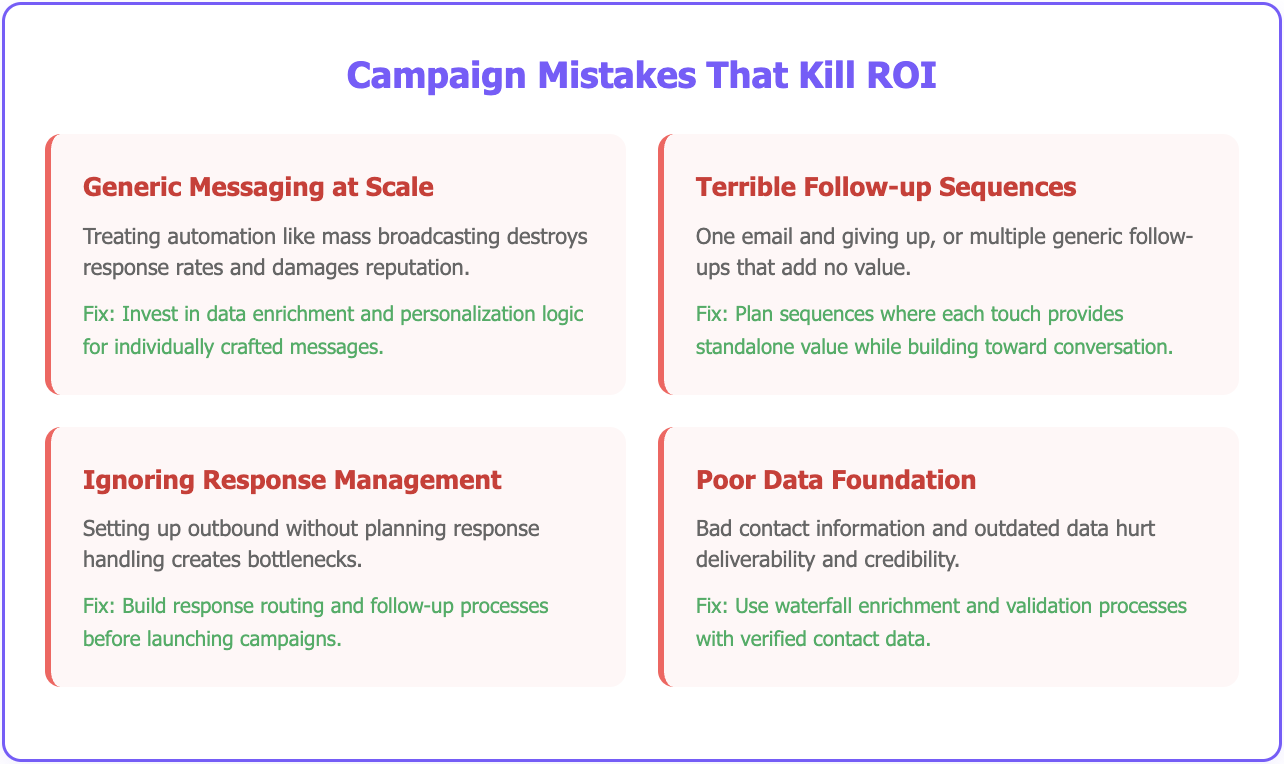
Generic Messaging at Scale
Biggest mistake is treating automation like mass email broadcasting. Generic messages destroy response rates and damage reputation.
Fix: Invest heavily in data enrichment and personalization logic. Every automated message should feel individually crafted for that specific prospect's situation.
Terrible Follow-up Sequences
Most campaigns send one email and give up, or send multiple generic follow-ups that add no value.
Fix: Plan touch sequences that each provide standalone value while building toward natural conversation. Reference previous messages and add new insights each time.
Ignoring Response Management
Setting up outbound campaigns without planning for response handling creates bottlenecks and wastes opportunities.
Fix: Build response categorization, routing, and follow-up processes before launching campaigns. Interested prospects should get immediate, high-quality attention.
Poor Data Foundation
Automation amplifies data quality issues. Bad contact information, outdated company data, and incorrect personalization details hurt deliverability and credibility.
Fix: Use waterfall enrichment from multiple sources and implement validation processes. Never send campaigns with unverified contact data.
Platform and Tool Recommendations
Successful lead generation email campaigns require integrated platforms that handle prospecting, enrichment, outreach, and response management:
Complete Campaign Platforms
Instantly provides email automation with A/B testing and more. Strong deliverability and the option to send emails from multiple email accounts make it popular for scale-focused teams.
Smartlead offers advanced sequence management with good deliverability optimization. Particularly strong for agencies needing multiple workspaces.
SalesForge provides outbound email automation with campaign sequencing and deliverability tools. Suited for sales teams seeking simple setup and reliable inbox placement for high-volume outreach.
Reply.io offers multichannel outreach combining automated email, calls, and LinkedIn touches with sequence branching and A/B testing. Popular with teams and agencies that want integrated engagement and detailed performance reporting.
Data Intelligence and Enrichment
Databar.ai provides the trigger-based prospecting and data enrichment that makes campaigns successful. Instead of static lists, it continuously identifies prospects showing buying signals and delivers them with complete context.
The integration approach means Databar feeds qualified, enriched prospects directly into your chosen email platform, creating a complete campaign workflow.
Supporting Infrastructure
- HubSpot or Salesforce for CRM integration and pipeline management
- Calendly for automated meeting scheduling from email responses
- Zoom or Google Meet for prospect meetings and demos
Building Sustainable Campaign Success
The most successful teams treat lead generation email campaigns as strategic advantages rather than tactical activities:
Start with quality triggers: Use behavioral signals rather than demographic guessing to identify prospects ready to engage.
Invest in data quality: Bad data kills even great campaigns. Use comprehensive enrichment and verification before sending messages.
Focus on timing: Reaching people at the right moment matters more than perfect messaging to random prospects.
Provide consistent value: Every touchpoint should help prospects succeed, not just push your agenda.
Measure what matters: Track revenue impact rather than vanity metrics to optimize for business results.
Build systematic processes: Successful campaigns require repeatable systems, not heroic individual efforts.
Done right, lead generation email campaigns become predictable pipeline generators that consistently deliver qualified opportunities. The key is combining behavioral targeting, quality data, and systematic execution rather than hoping generic outreach will somehow work.
Choose tools that integrate well, focus on metrics that matter, and remember that successful campaigns help prospects solve problems rather than just generating meetings. Build campaigns that prospects actually want to receive, and response rates will take care of themselves.
Frequently Asked Questions
What makes lead generation email campaigns different from regular email marketing?
Lead generation email campaigns focus specifically on identifying and converting prospects into sales opportunities, while regular email marketing often targets existing customers or broader audiences. Lead gen campaigns use behavioral triggers, comprehensive prospect data, and sales-focused messaging to drive meetings and opportunities rather than general engagement or brand awareness.
How many emails should be in a lead generation sequence?
Most effective sequences include 2-4 step email sequences. The first email references the trigger that qualified them, followed by value-adding messages like case studies, industry insights, and social proof. Each email should provide standalone value while building toward a natural conversation opportunity.
How do I avoid my lead generation emails going to spam?
Focus on data quality, sender reputation, and message relevance. Use verified email addresses, maintain low bounce rates, avoid spam trigger words, and ensure messages provide genuine value. Waterfall enrichment from multiple data sources helps ensure contact accuracy, while trigger-based targeting improves engagement rates that boost deliverability.
What's the best way to personalize lead generation emails at scale?
Use comprehensive data enrichment to reference specific triggers, recent company developments, and relevant context. Databar.ai provides behavioral triggers and enriched prospect profiles that enable natural personalization like "Saw you're hiring a Marketing Ops Manager" rather than generic approaches.
How quickly should I follow up on lead generation email responses?
Respond to interested replies asap. Prospects who respond positively are showing immediate interest, and delays reduce conversion rates significantly. Set up response routing and alert systems to ensure interested prospects get immediate attention from qualified team members.
Can small companies compete with larger organizations in email lead generation?
Absolutely. Smaller companies often have advantages in email lead generation - faster decision-making, more personalized approaches, and ability to target specific niches. The right tools like Databar.ai for trigger-based prospecting level the playing field by providing access to the same data intelligence and automation capabilities that larger companies use.
What's the biggest mistake companies make with lead generation email campaigns?
The biggest mistake is using generic, spray-and-pray approaches instead of targeted, trigger-based campaigns. Companies download static lists, send one-size-fits-all messages, and wonder why response rates are terrible. Success requires reaching the right people at the right time with relevant, personalized messages that address their specific situation.
Related articles
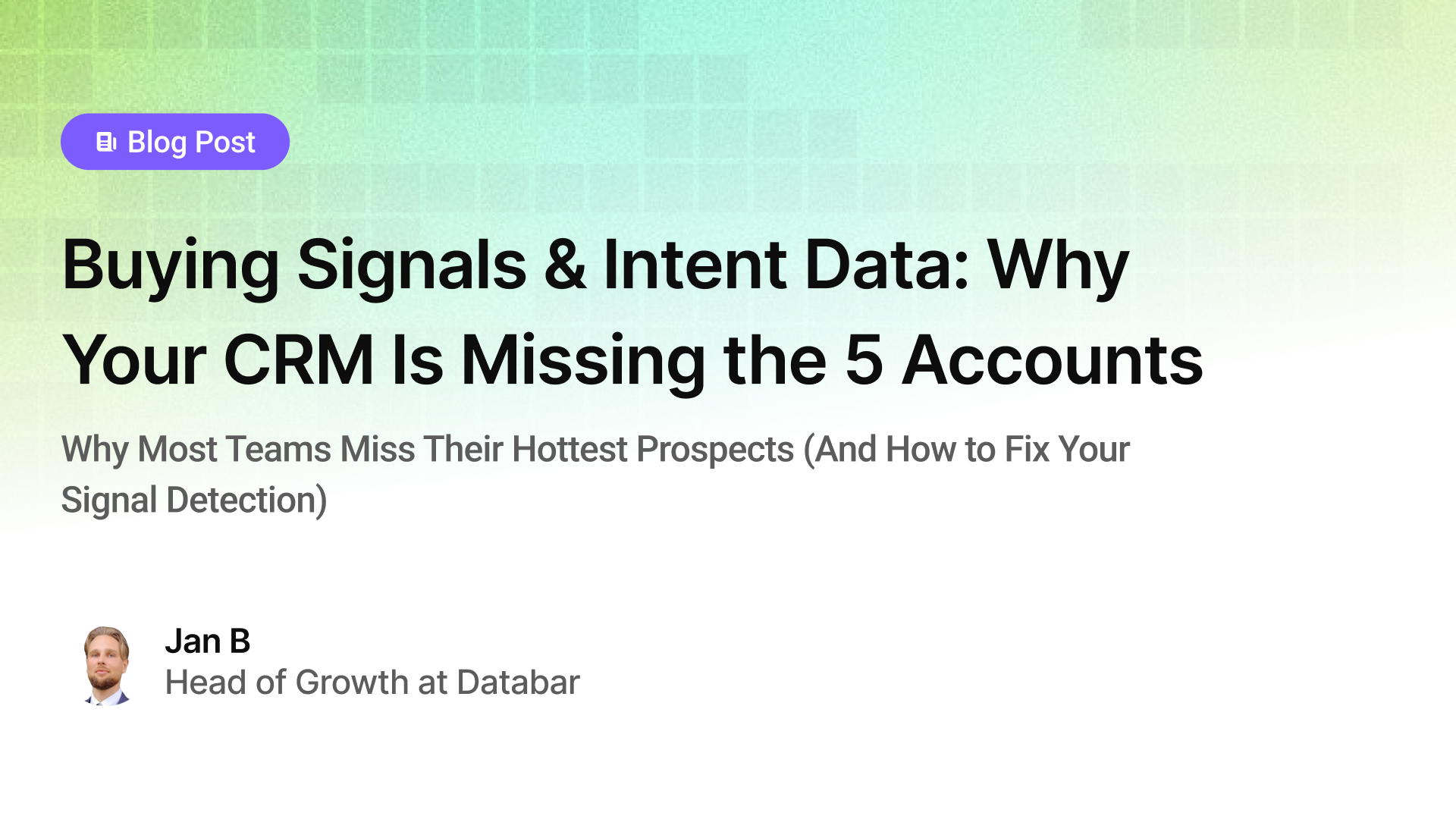
Buying Signals & Intent Data: Why Your CRM Is Missing the 5 Accounts
Why Most Teams Miss Their Hottest Prospects (And How to Fix Your Signal Detection)
by Jan, October 06, 2025

Lead Scoring & Account Segmentation: Why Most CRMs Get This Backward (And How to Fix It)
How to build a system that tells your team who to call, when, and why
by Jan, October 06, 2025
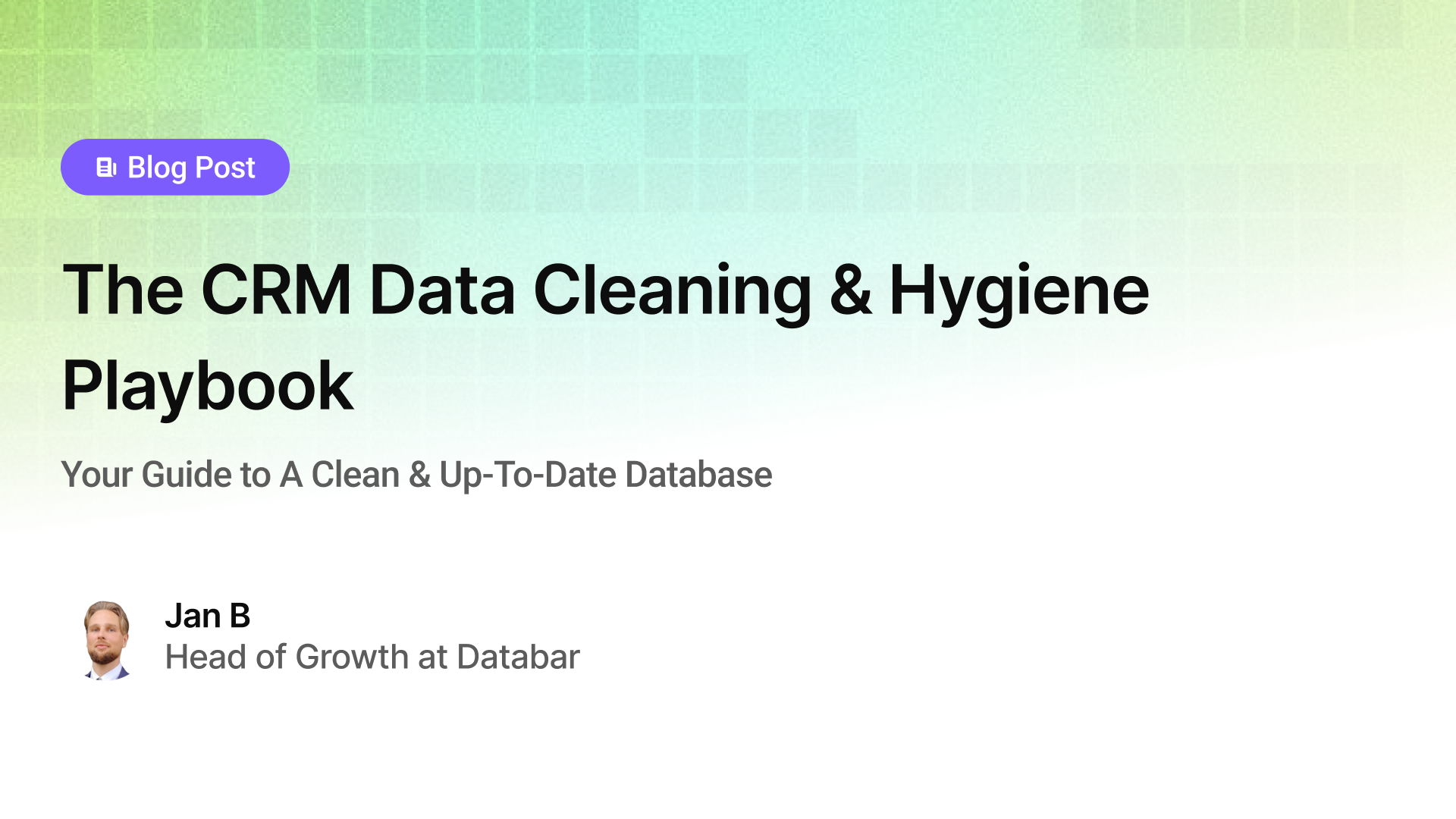
The CRM Data Cleaning & Hygiene Playbook
Your Guide to A Clean & Up-To-Date Database
by Jan, October 04, 2025
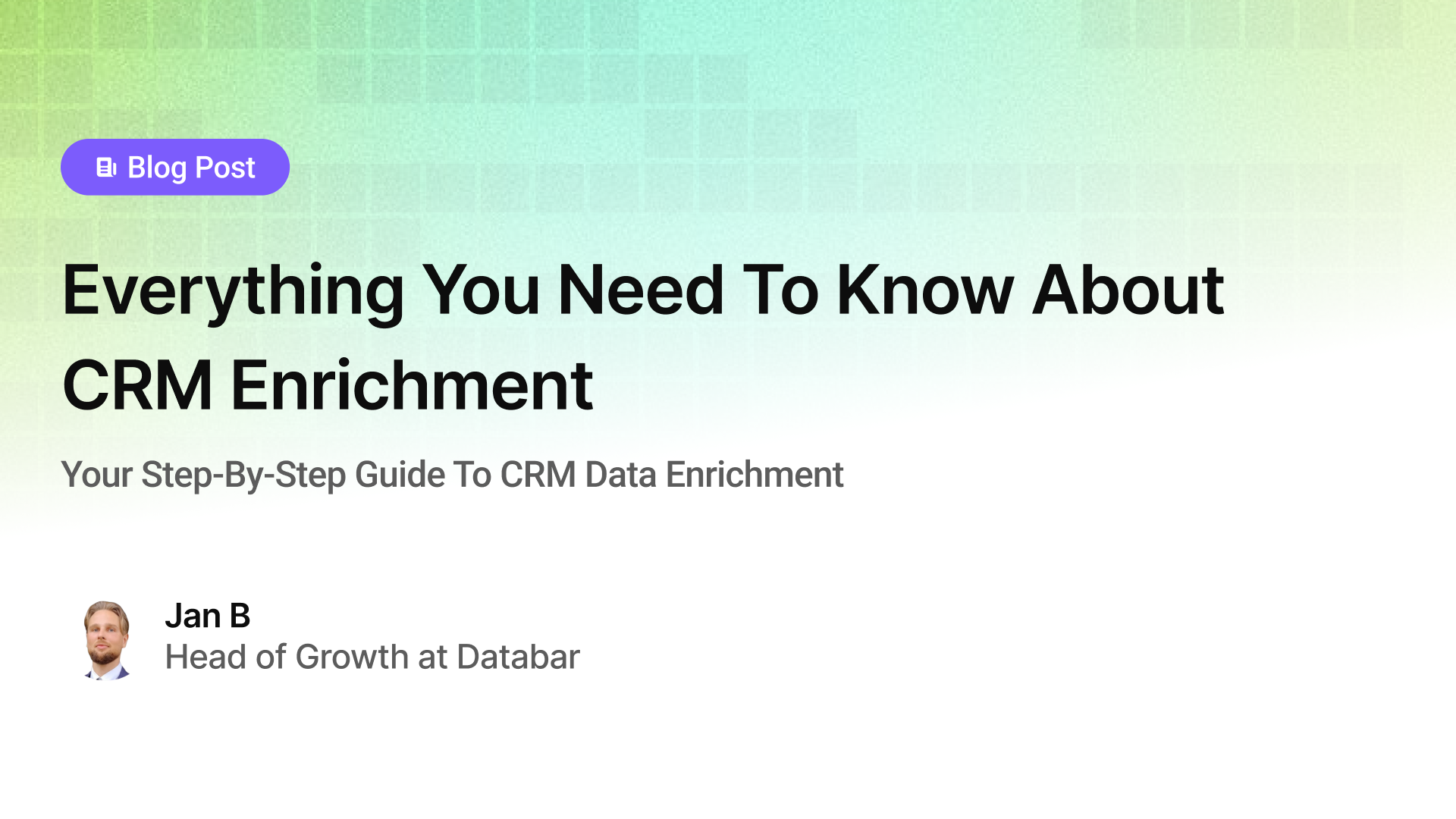
Everything You Need To Know About CRM Enrichment
Your Step-By-Step Guide To CRM Data Enrichment
by Jan, October 03, 2025

